#i just think its important to remember that genres exist in a bit of a loop of information
Explore tagged Tumblr posts
Note
Hello there, do you mind sharing your favorite bls of 2024? Thanks!
hi! honestly i suck at keeping track of shows and ranking them asdfghjkl i want to keep better track next year tho and maybe even make some celebratory gifsets but we shall see!
and since you asked for it, i decided to check mdl and do a deep dive on which shows have aged well in my mind and score lmao
my top rated dramas of 2024 are:
love for love’s sake
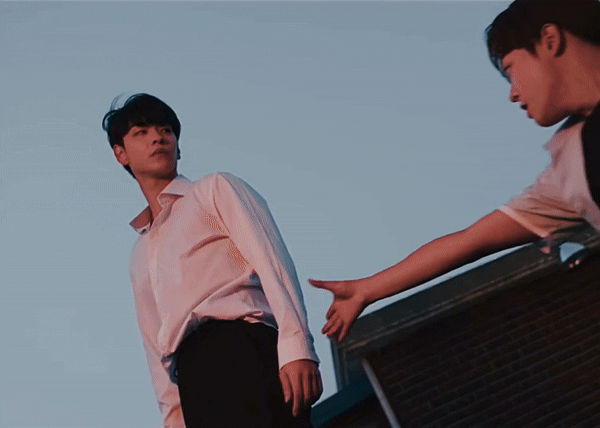
my only 5 stars drama of the year. doesn’t surprise me at all. this show took me completely my storm at the beginning of the year. it has such a compelling story and it’s so efficient on so many levels. but most importantly, it sticks the landing. it gives closure to a story that wasn’t even finished. and it does so well. the definition of lightning in a bottle!
love in the big city
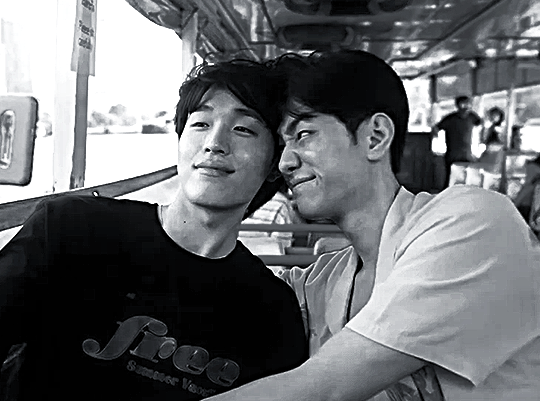
this show made me feel emotions unknown to humanity so i get my rating asdfghjkl felt really personal to me. it is also incredibly efficient and very necessary!
knock knock boys!

i said it halfway through its run and i’ll say it again: one of the best bls of 2024. no wonder i rated it this high asdfghjkl within its premise it promised very little and delivered soooo much with some incredible takes. while i love when bls do new things, to me a story told well is fantastic regardless of how cliché it might be to some. and knock knock boys manages to feel very familiar but also very refreshing with the way it handled some topics. super funny and it stuck the landing to me. in a completely different way from love for love’s sake but very satisfying!
jack & joker: u steal my heart!
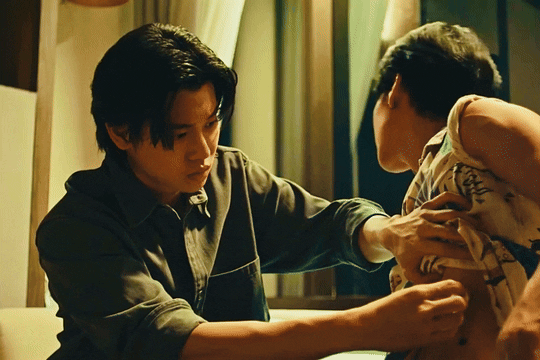
this is the thai bl of the year to me. for all the conversations it started, interesting characters, refreshing plot and also for existing purely on the love and dedication of its creators. while it is not perfect, i do hope that when we look back on 2024, we see it as the year of jack and joker
century of love
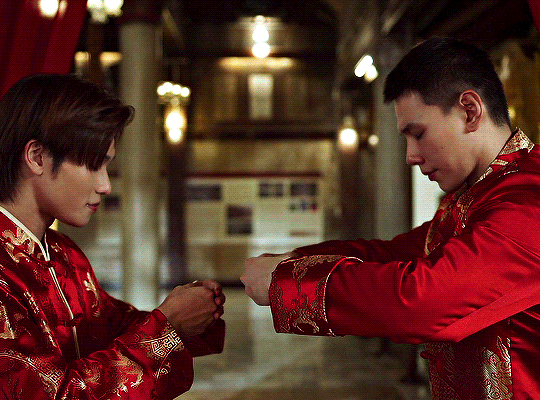
i’ve loved daouoffroad since love in translation. i was a bit skeptical of century of love at first but i ended up loving it a lot. i’m also not surprised at all this made my top 5 asdfghjkl
now i would like to add a few shows that haven’t finished airing yet but had most of their run in 2024 and i’m pretty sure they’re going to be in top rated dramas
miseinen (our youth)
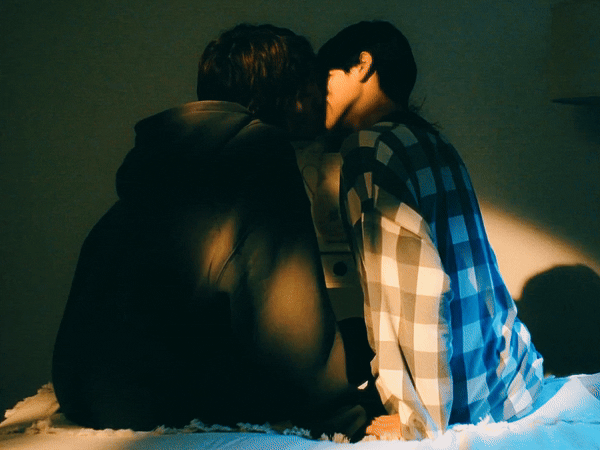
it is the japanese bl of the year to me. hands down. i could rant but at the same time i have no words asdfghjkl this show goes beyond efficiency or even sticking the landing (which i hope they do), but it’s the whole vibe. because while incredibly sad, you can see how much love and care exists in it. the characters are so alive and so complex and beautiful and godddd i love them. 10/10 no notes
see your love

came out of nowhere promising very little and delivered one of the best bls of 2024 imo. i don’t even remember when was the last time i felt compelled to gif a taiwanese bl but this show is sooo inspiring and fun and important. i just love it
caged again

this show promised nothing except wacky plot and delivered such a hilarious and compelling and heartfelt story. i love when i get these little surprises. shall live on in my heart
honorable mentions:
let's eat together, aki and haru 2: more please!

my only other 5 stars of the year. but it’s a movie so i didn’t include it up there. still. it’s a nearly flawless execution of a beautiful genre that i love: queer stories revolving around food and domesticity. it delivered exactly what it promised efficiently and i loooooove it so much!!!!!
sugar dog life

also came out of nowhere promising nothing and delivered a really solid little story, also revolving around food and domesticity. can you tell i’m biased lmao
the rebound

BALL IS LIFE!!!!!! we need more bls about sports. asap. we don’t have enough!!!! and this show was a surprise to me. i ended up super invested for the most part and i do think it stands out in the tiny little corner of bl sports therefore it deserves an honorable mention
blue canvas of youthful days
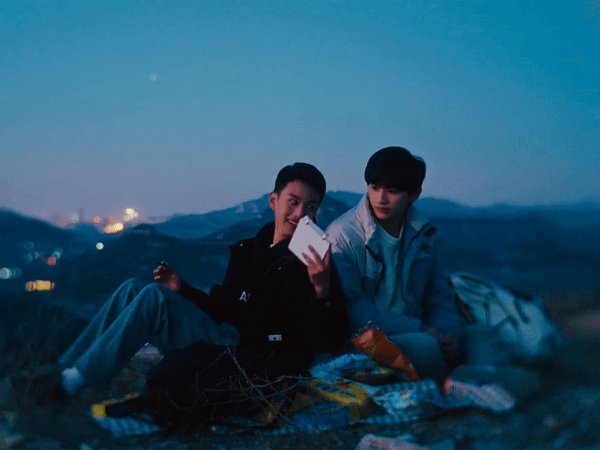
chinese bls always have a special place in my heart for fighting so hard to exist. this one is no exception. it got taken down when it first started airing and i’m glad they managed to release all of it eventually. it’s far from being perfect but i was still thoroughly invested in it. i love the main couple with my entire heart. and i’m soooooo grateful they got their happy ending!!
monster next door
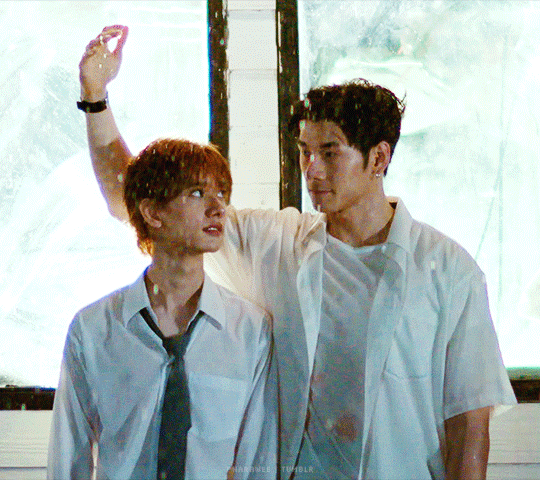
as a deeply introverted person, this is the representation i needed asdfghjkl it felt refreshing and a conversation worth having about respecting introverts and other people’s ways of living. plus diew is autistic to me (source: i’m autistic) and it was an overall good show!!! bigpark my beloveds!!
and that’s it! thank you for asking ����
41 notes
·
View notes
Text
Ok so theres this documentary sisters with transistors abt women in electronic music i watched a couple years ago and at the time i remember thinking it was a bit flawed in its focuses but was still intrigued by what it did depict which was the amount of technological engineering know-how it took to make electronic music in its early years. But also the doc barely touched on wendy carlos whose importance to electronic music is pretty ubiquitous even to the most terminal-indie-folk-listening even slightly-online queer person. And also well sure a doc has to limit its scope but retrospectively it feels actually so egregious to make a documentary about electronic music in general and not even brush the topic of dance music. Which is of course a genre invented and pioneered by black people. With significant contributions by black women of course. And just now i went into the lb reviews for said documentary to make sure i wasnt misremembering the artists it focuses on and every critical review rightfully points out the lack of depth in wendy carlos’ segment. But of the top ~20ish reviews only one mentions how white the doc is. 😑.
I think generally theres a dismissiveness toward dance music as not being serious and some of that is the contemporary association of it with mass-market raveslop edm and some of that is because theres an idea that something cant be designed for as “”vapid”” a type of fun as going to the club and also be seriously artistically crafted and also thats all tied up in racism and classism bc of the specific communities and musical scenes that pioneered those types of music. And which are the communities and scenes that continue to keep these genres fresh like all the best contemporary techno i know is from latin america. Anyway. Thank u to black djs from chicago for house music and thank you to black djs from detroit for techno and thank you to all the women that allowed the music i love to exist that is all
#i love the nerdy engineering weird moog music of the 60s-70s ofc#but to overlook dance music the best most important thing in the world#deeply sinister#this is my retroactive review of sisters with transistors (2020)#<- two years later
9 notes
·
View notes
Text
The Twelve Kingdoms is one of those animes that deserves more love. Sure, it’s ugly by todays standards, but it has some of the best world and character building I’ve ever seen. The isekai genre usually uses its premise to seamlessly introduce the audience to its fantasy world. The protagonist doesn’t know anything, so the audience can learn the ropes alongside them, seeing through their eyes. The Twelve Kingdoms, on the other hand, wants a rocky, painful introduction to its world. Yoko is hurled into the world with no explanations, where she is a part of a hated underclass and being actively hunted by the highest power in the land. The show goes to great lengths to stick you in her shoes. Not short of making a whole conlang, so that you feel just as confused as she does. No kidding, when I was first watching Twelve Kingdoms I thought that the sub I was using was just not translating some Japanese words, expecting me to be weeb enough to get it. But no. Those are words for concepts that can’t be translated into Japanese by Yoko’s innate knowledge of the new language (and were never meant to be understood by the audience, or Yoko.) In addition to the conlang confusion, the show goes out of its way to explain nothing. Why is Yoko the chosen one, and for what is she chosen? Why are they being attacked, and by who? Who was that white haired guy who swore fealty to her and what does he want? Why does he turn into a unicorn, get blood dumped on him, and then get kidnapped? Actually, that whole scene where Keiki gets kidnapped would make a lot more sense if it was a flashback later on in the show. Yoko doesn’t even see that event- it’s presented in its chronological place solely to be a confusing wtf moment. All of this confusion works together to make you, the audience, empathize with how scared and out of place Yoko feels. The girl can’t even feel safe in her own body- she gets genetically rewritten, can speak a new language, and has a goo monster living in her now. She doesn’t get an explanation as to why any of this is happening and it’s painful.
It’s important for the show to make you empathize with Yoko, because she’s not going to be doing any “likeable character” work for a little bit. She starts out as a very weak person, who’s thrust into a leadership role by virtue of being the only one who can speak the language, and she does a terrible job. Her friend group dissolves into infighting. She’s too limp wristed to make good decisions. And she ends up alone. The series explores how her upbringing surrounded by sexism has damaged her. Her self image is that of being a good woman, a good girl who doesn’t hurt others. But when she learns her friend genuinely hates her, that she has hurt them, that self image is shattered. Betrayal after betrayal by the world, and Yoko accepts that hurting people is the only way to get by. And if she can’t be that acceptable good woman, then the world has no place for her, and she doesn’t owe it anything either. She has no confidence that she is strong enough in her own identity to exist outside of acceptable womanhood. So she stops being acceptable all together. She gives up on learning anything new, gives up on learning with the world, and resorts to violence to force her way. The series throws you and Yoko down into this hellish world so that it can break Yoko down to her lowest point.
So Twelve kingdoms is a confusing show with an unlikable protagonist, you may be thinking? Why do you want me to watch this? Because the payoff is wonderful. Do you remember Rising of the Shield Hero? Yoko’s like the Shield Hero, but the betrayal that makes her give up on society is xenophobia from that society. And the solution to resolve her disillusionment is receiving kindness and grace from a denizen of the new world who is equally disenfranchised. So Twelve Kingdoms is Shield Hero, if it was actually good. Yoko gets reminded of her common humanity, and slowly comes out of her funk. She starts learning about the world again and realizes that there is a way out of her current predicament- she can escape to a country that’s less racist. She begins to feel genuinely thankful for the people who have gotten her this far. She draws a line of acceptability for herself, that she won’t cross for her own sake. This show lets you watch Yoko become a person. She decides that even though she doesn’t know why she’s here, she values herself and the people around her, and that’s enough to live with purpose. It’s a really good character arc, and it reminds me of one of my all time favorites, Yona of the Dawn.
Once Yoko gets to this level of confidence, she becomes ready to learn. And finally, the show teaches you the conlang. It’s so satisfying to be able to understand what has happened up till now in retrospect. You even learn what happened with that weird guy who turned into a unicorn and got kidnapped. The chaos of the first episode gets reframed into an unfortunate event in history, brought about by subterfuge and political intrigue. And that’s how the rest of the story is framed too. The Twelve Kingdoms is a historical record of what happens within the twelve kingdoms, and Yoko, though she didn’t know it at first, is now a player on the historical stage. The series won’t focus on her so closely from here on out. It instead examines other historical events and characters that surround her. She is no longer the protagonist, instead the Twelve Kingdoms themselves are. Is this a plot twist? Whatever it is, there is only one word that I can describe it with, and that is “grand.” Every heart wrenching struggle Yoko delt with up till now could be summed up with no more than a single sentence in the tombs of history. And The Twelve Kingdoms is history, with all the vastness it entails. If worldbuilding is the art of making a world feel big, then there can be no finer examples than the Twelve Kingdoms.
24 notes
·
View notes
Text

INTERVIEW WITH A WRITEBLR — @broodparasitism
Who You Are:
Lottie || She/her
I’m Lottie, and I’m currently doing a master’s in creative writing. I mostly write things in between historical, literary and horror about postwar Britain, and other than writing I’m a bit of a music nerd!
What You Write:
What genres do you write in? What age ranges do you write for?
Historical Fiction, Horror, Paranormal, Psychological. Adult.
What genre would you write in for the rest of your life, if you could? What about that genre appeals to you?
Literary, if only for its room to be experimental and weird.
What genre/s will you not write unless you HAVE to? What about that genre turns you off?
Romance - I’m just not a romantic type of person!
Who is your target audience? Do you think anyone outside of that would get anything out of your works?
I don’t think too much about it, but I think other young queer/neurodivergent women would be the biggest readers of my work, particularly if they’re also British. But I hope that anyone from any demographic would be able to get something out of my work! It’s for anyone who wants to read it.
What kind of themes do you tend to focus on? What kinds of tropes? What about them appeals to you?
Motherhood is something that always creeps up in my work. Hedonism and moral masochism as contrasts is also very important to me! Feminism and class tensions tend to have a big presence in my work as well. It’s harder to say with tropes but if the central themes are there the tropes don’t matter too much to me. I couldn’t get into why they’re important to me without getting much too personal for writeblr, however.
What themes or tropes can you not stand? What about them turn you off?
Something entirely fluffy and comforting or something entirely cynical and hopeless, albeit the first is more annoying. I need some degree of light and darkness or the story feels too uncomplicated to me. For something very specific, I’m not keen on premises where every type of fantasy folklore is incorporated: there’s often too much that isn’t fleshed out enough. I also hate stories that use weight loss as shorthand for positive character development, because that’s plain old fatphobia. And stories without women. There’s no excuse for that.
What are you currently working on? How long have you been working on it?
I’m working on a manuscript for my MA so I prefer to keep vague on it, but it’s a small town horror about four people in the early 80s coming to terms with a recent death of someone they all had a wildly different relationship with and the way the town becomes increasingly haunted. I’m quite attached to it now. I began working on this at the end of August 2022!
Why do you write? What keeps you writing?
It simply brings me joy to do it. I want the stories in my head to exist on paper, because that’s such a rewarding feeling!
How long have you been writing? What do you think first drew you to it?
On and off since I was very young. I can’t remember what drew me to it: it was just something I knew I wanted to do for as long as I can remember (cliche, I know). I say that I began seriously writing in November 2013, when I started what would become my first completed draft of a manuscript.
Where do you get your inspiration from? Is that how you got your inspiration for your current project? If not, where did the inspiration come from?
I get my inspiration from my local area, and from researching history - and very often, music with connection to that. I think that the starting point of inspiration for my current project was the band Xiu Xiu, but what nonfiction I’ve read since then has fleshed it out into an actual narrative.
What work of yours are you most proud of? Why?
A short story called ‘Minutes’ that helped me get into my MA in the first place. I just struck gold with the plot, and it’s naturally one of my most “polished” pieces of writing. I would ideally like to do something else with it!
Have you published anything? Do you want to?
Not yet, but absolutely in the future.
What part of the publishing process most appeals to you? What part least appeals to you?
The publishing process doesn’t appeal to me at all - I’m not yet familiar with it. I am afraid of having to water down my work for “marketability”, however.
What part of the writing process most appeals to you? What part is least appealing?
It’s quite hard to say. I like the feeling of when an idea comes to you just as you’re typing. That’s always a godsend. The part least appealing…it can be quite intimidating when things are workshopped, definitely.
Do you have a writing process? Do you have an ideal setup? Do you write in pure chaos? Talk about your process a bit.
I don’t have much of a process. I have to be able to write almost anywhere and at any time of day in order to get things done.
Your Thoughts on Writeblr:
How long have you been a writeblr? What inspired you to join the community?
My currently blog is under a year old. I was peripherally involved from about 2018 to 2021, after which it became my primary tumblr community.
Shout out some of your favorite writeblrs. How did you find them and what made you want to follow them?
Some of my favourite are @queenslayerbee, @aninkwellofnectar , @ryns-ramblings, @dallonwrites! Tumblr either suggested I follow them or I found their blogs via discord.
What is your favorite part about writeblr?
I like a lot of the tag games - especially find the word.
What do you think writeblr could improve on? How do you think we can go about doing so?
In the nicest possible way, a lot of the writing advice is really, really bad. I am begging writeblr to realise not everyone needs to post writing advice and that is okay!
How do you contribute to the writeblr community? Do you think you could be doing more?
I could be doing more, but I have reservations about sharing my own work and I’m not qualified to be giving advice so all I can do now is help promote others.
What kinds of posts do you most like to interact with?
Posts that ask a question to the community as a whole about their creative processes, tag games and excerpts also.
What kind of posts do you most like to make?
I don’t know! There’s not a lot of writeblr posts I can make. I do like making silly little jokey posts about what I’m writing that only make sense of me, I suppose.
Finally, anywhere else online we may be able to find you?
I am on storygraph as @/fortunavhs, Instagram as @/absinthiumwriting and discord as malcontent#7884!
7 notes
·
View notes
Text
SIGYN’S TOP 5 ALBUMS OF 2024: #5 - Queen I - the 2024 remaster
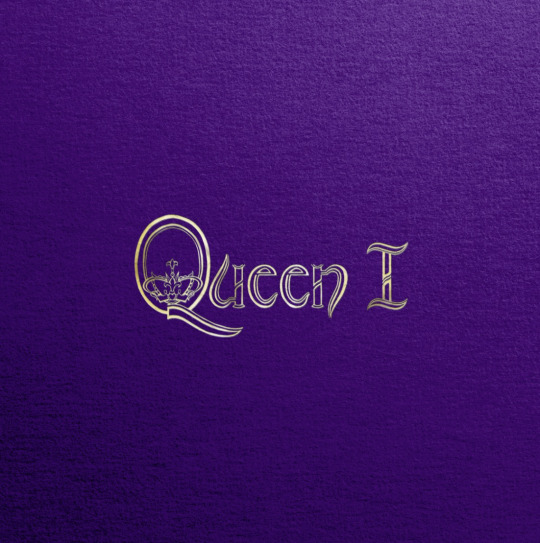
The 2024 remaster of Queen’s self-titled debut album, here renamed from just “Queen” to “Queen I” to acknowledge the existence of follow up album Queen II, sits at the bottom of my list exclusively by virtue of being a remaster/re-release and not an all new album. The original master of Queen I is plagued horribly by production and audio quality best charitably described as Crunchy, in a way no lossless vinyl transfer FLAC can remedy. While I don’t always find remasters to be especially useful when they’re of recent-ish albums which sounded fine to begin with, if there was ever an album that needed a proper modern remaster to clean it up it’s this one. Unlike some remasters the audio quality difference here is IMMEDIATELY noticeable especially on some of the crunchiest original tracks - “Liar” probably comes out the best here, basically sounding like you’re finally hearing it the way it was actually meant to be heard. In addition to finally uncrunching the original masters Queen I bundles a whole bunch of bonus content, mostly demos, alternate takes and parts of the Live At The Rainbow live album. These are interesting enough if you like Queen enough to be interested in the minute variances and different expressive takes of the songs, but beyond the cleaned up original masters the best thing here are the backing track development & demo tracks, most of which include some - or a lot - of ancillary spoken vocal, spoken timings, commentary on the recording process, or just adorable artistic frustration. The absolute best thing here is My Fairy King (Trident Backing Track In Development) which is a 6-minute audio recording of Freddie & the guys trying to lay down the backing track for My Fairy King and growing increasingly, adorably frustrated trying to master the song’s light speed piano intro. Freddie talks and complains and curses, all with warm laugher in his sweet voice, always so high and gentle. The assorted legendaria of Queen has always been that outside of his larger than life crowd-mastering stage personas Freddie was actually an incredibly quiet, sweet, gently mannered person, it’s so abundantly clear here. Being a metaphorical fly on the wall to the unspeakably intimate, casual moments as the greatest band in history play, talk, and tune their instruments is so overwhelming that playing this for the first time had me sobbing in my car, imagining a world where Freddie is still here with us. Because make no mistake - this is the greatest band in history, and that’s an opinion I will take no rebuttals on. The Beatles can have spot number 2. Without Queen there would be almost none of what I love so much that came after, across so many genres. I can think of few bands or artists I love that don’t have at least a little bit to owe to Queen, from Rhapsody of Fire and Trans Siberian Orchestra to a particular well loved emo rock quartet whose legacy, aesthetic, and general thing is so tightly intertwined with Queen’s that they’ve been being mentioned in the same breath for as long as the latter existed; you can almost map the members’ personalities onto each other 1-for-1. Because it’s important to remember that the early 2000s emo-rock explosion, and most especially the hyper-theatrical trinity at its center, are the inheritors of this legacy. Without Queen, there is no Panic at the Disco (a fact which becomes painfully obvious listening to some of shameless hollow retreads on Viva Las Vengence), there is no Fall Out Boy, and without Freddie, Brian, Roger and John, there is very certainly no Frank, Mikey, Ray and Gerard.
There are times where the foundational and codifying texts of a genre become somewhat comparatively boring over time, easy to appreciate and respect for their importance but feeling sort of primitive and uninteresting compared to the dozens of things which evolved and expanded improved on their work in the years or decades after. This is very much not so with Queen. Queen are, I think, one of those bands who somehow remain under-appreciated despite being one of the most famous and loved bands of all time, I think there are few people alive on earth who don’t know Bohemian Rhapsody by heart but far fewer who’ve dug into the deep cuts on things like Hot Space and Jazz. If you’ve ever liked Queen at all, at any point, go pull the Queen I remaster up and give it a listen - it will remind you, if you ever forgot, why Queen are in fact the band of all time.
4 notes
·
View notes
Text
Of Stoats and Systems
Things are getting heated on various platforms but rather than @ anyone and contribute to the engagement spiral I thought I'd just lay out the various pieces of information that have caught my attention about Dimension 20's upcoming season, and the inferences and assumptions that I'm bringing to them, and see whether any of it resonates.
Evidence
Exhibit A: In the first Fireside Chat, the talkback show for actual-play podcast Worlds Beyond Number, Erika Ishii references a "cyberpunk Watership Down" concept, and is hushed by Aabria Iyengar, who says that it may be coming up sooner than Erika thinks.
Exhibit B: In the SAG-AFTRA production signatory database, a season of Dimension 20 is listed with the working title of Stoatal Recall.
Exhibit B.5: The 1990 film Total Recall (as well as the 2012 remake), based on a 1966 short story by Philip K. Dick, "We Can Remember It for You Wholesale," concerns a man who undergoes a memory-alteration procedure which may or may not turn him into a superspy, depending on whether the events of the movie are all in his head or not. The important part here is the theme of ability enhancement.
Exhibit C: Once the Burrow's End trailer was released, the two pieces of media that were officially referenced by Dropout as inspirations for the season were very obviously Watership Down (1972 book, 1978 animated adaptation) but equally consequentially, The Secret of NIMH (1982 animated adaptation of the 1971 book Mrs Frisby and the Rats of NIMH).
Exhibit C.5: The central premise of the NIMH stories is that experiments done on rats by the National Institute of Mental Health gave them human-like intelligence, organizational capabilities, and (in the movie) access to magic and the use of weapons.
Exhibit D: Aabria, in both a Bluesky post and a Tumblr tag essay which have been widely shared, has explained that she chose 5th Edition Dungeons & Dragons as the system for Burrow's End not due to comfort with a familiar system or to commercial pressure to not deviate from what fans are used to, but because particular elements of the system design lent themselves to the specific story she wanted to tell in ways that no other TTRPG she knew could.
Cross Examination
Now, many people have taken this to mean that intense and recurring violence is a central aspect of the season, since one of the most obviously robust elements of D&D is its battle simulation mechanics. (There are, of course, many TTRPGs which incorporate mechanics for drawn-out, granular combat, several of which position small woodland creatures in a big dangerous forest instead of traditional fantasy races in a fantasy realm as the protagonists.)
Others have suggested that D&D's elaborate magic system is the key element, since bits of the trailer suggest that the Stupendous Stoats are granted some kind of magical abilities by the Blue. (Games where woodland creatures specifically use magic are rather thinner on the ground, but there are again many TTRPGs that support a wide variety of magical abilities with a high degree of customization.)
I've even seen people proposing that D&D's fundamental origins as a killing-and-looting game rooted in 20th century imperialist narratives in which powerful people go into uncivilized lands, plunder their treasures and are considered heroes for it, is the point, especially since stoats are predators that take over the burrows of animals they kill, and are an invasive species in some parts of the world. (Other games about imperialist conquest and the ramifications of power achived by violence do exist, although it would be untrue to say that D&D is not the market leader there.)
Closing Argument
But if I'm looking at the themes of the works that appear to have been the most direct inspiration for Burrow's End, there's something else that D&D does more completely, if not actually better, than just about every other system.
A fundamental theme of the cyberpunk genre is the use of technology to exceed current human limitations, whether through biohacking, neuromancy, or even merely robotics so advanced as to be indistinguishable from humanity. Even if the technological element does not seem to be overtly present in Burrow's End, exceeding limitations does.
As a film, Total Recall was deeply influenced by cyberpunk, which was itself deeply influenced by Philip K. Dick's work, but the concept of a procedure which could endow a normal man with the capacity for action-movie violence and a deeper awareness of the reality behind the façade of the everyday is, obviously, older than cyberpunk.
In Watership Down, rabbits whose mental abilities exceed those of other rabbits often attribute them to a kind of mystical communion with deific figures in rabbit mythology; in the NIMH stories, the rats' enhanced abilities are more straightforwardly attributed to human experimentation.
In every case, the concept of abilities that increase over time and exceed the natural physiology of the protagonist species is an essential part of the worldbuilding of the source material. And what D&D does more of than almost every other system, perhaps what it does to excess, even to the exclusion of design elements that would better contribute to a satisfying narrative, is power leveling.
Speculation
As you might expect from the foregoing, I take the position that power leveling is, in itself, not particularly compelling as a central narrative (unless your horizon for compelling narratives is limited to video-game RPGs and shonen anime, I suppose), even though it's endemic as a narrative device. As I sarcastically noted elsewhere: "it's impossible to have adventure without also having power fantasy, I've been told by every media property aimed at boys since the Carter administration."
But the tone of the trailer for Burrow's End is hardly that of a shonen anime or Schwarzenegger film. And as a listener of Worlds Beyond Number I can't really believe that Aabria just wants to level up her stoats to a point where the dangers of the forest are trivial and even the dangers of whatever human institution (there are camo-covered trucks tucked away in the DM screen) may be responsible for their ability score increases are managable. What I can't stop thinking about, what tantalizes me, is the possibility of power leveling as a narrative device that can go both ways. What if deleveling is also on the table?
And the work I haven't seen anyone else reference but has always been paired in my head with Mrs Frisby & the Rats of NIMH since I read them both as a tween, one of the supreme works of sci-fi psychological horror (even though it isn't usually discussed in those terms), is Flowers for Algernon.
#dimension 20#burrow's end#long post#maybe spoilers for burrow's end?#i don't know#am i getting my hopes up and it's just going to be another scrappy band of heroes against cosmic evil at the end?#maybe#but that's brennan's m.o. not aabria's#okay that's enough fussing over an overlong tumblr post
16 notes
·
View notes
Note
I don’t know if you remember this, but I once sent you a really fucking dumb ask that described sitcoms as “painfully white”, among many other stupid things. I would like to apologize for that, fully. I actually love sitcoms, and I’m ashamed that I let your’s/Lily’s extreme, dogmatic OBSESSION with/hilariously impotent rage at people who just DIDN’T fucking like them. Make me feel like I had to reactively hate them as a result. Some of my favorite shows are sitcoms, I’m literally laughing my ASS off to one in the background while typing this, and I’m more than happy to say that I don’t think ANYBODY is a “fascist” for never giving a sitcom a second glance.
See, I thought that your’s/Lily’s extreme insecurity about y’alls OWN enjoyment of a tiny handful of specific sitcoms. Meant that I would also have to reflect that same shit-flinging insecurity in my own love of sitcoms, and I fucking HATED that idea Ginger! Fucking HATED. IT!!!
But I’ve grown quite a bit sense then (as far as my enjoyment of sitcoms goes) and I realized that the myopic devotion to ONLY watching sitcoms/considering (a few of) them to be the ONLY fucking TV shows worth watching. Wasn’t an inherent aspect of enjoying sitcoms. I can enjoy sitcoms and also a WIDE variety of other media, within all different types of genres/tropes/characters, because that’s how normal people generally watch media.
MY problem was that I had spent a little too much time immersed the extremely rigid joylessness/ragebait of your’s and Lily’s accounts that ONLY ever consider a painfully narrow selection of media even REMOTELY worth fucking watching. That made me feel like it was all or nothing with sitcoms! But it’s not is the thing. You and Lily are just media illiterate fucking LOSERS who can’t handle watching anything other than the same five sitcoms on repeat for the rest of your nightmarish little lives.
When in reality, regular people enjoy TONS of more sitcoms than JUST the most ableist/racist ones. While also enjoying a ridiculously larger amount of types of stories/genres that you misery wallowing, terminally online shitweasels couldn’t even BEGIN to wrap your emotionally stunted fucking brains around!
You know genuinely there is nothing funnier than this fella continuing to write full essays to me on tumblr pleading and sniveling and begging for me to validate their hairline crack wide “media diversity” because I said once in a podcast over a year ago that liking more than one thing is important to being a healthy and functioning person-and they feel the need to prove that I’ve got a slim genre diversity streak because I talked about a single sitcom being pretty okay once 9 months ago and its literally all they think about.
Like geez man, the obsession is kind of tragic-its not even about media diversity. I’m not a person you’re fighting-I’m your fandom, aren’t I? I’m the thing that keeps you from expanding your horizons with my mere existence. You need me and desperately want me to know you exist. Im your blorbo.
How sad.
5 notes
·
View notes
Text
An Entry Level Guide To Fantasy Books: Fantasy Lit. 101
So, you wanna start reading fantasy, but you're kinda overwhelmed with the amount of books there are out there? As a fantasy veteran, I'll give you a couple of options of how to get into the genre and become well-seasoned, yourself :)
First, some important things to remember:
If you've never read fantasy before in your life, let me warn you: fantasy can be confusing. An element of fantasy is something called "world-building", where authors create a new world that is as divorced for ours as they would like it to be. This means there are different countries, languages, people, customs and institutions. If you've ever been to foreign country, the experience of beginning a fantasy book is quite similar - everything is weird and you don't speak the language.
This is why the first couple of chapters may be difficult. You will be unfamiliar with certain terms, for example, as well as lack the context to understand certain actions the characters make. However, remember: the author does not expect you to understand every element of their world at this stage of your reading journey. They understand you have just arrived in this world, and are learning. The situations and words you will see in the first couple of pages are usually there on purpose so that you will slowly learn them and finish the book understanding everything perfectly. Be patient with yourself.
It's also important to remember that many books are part of series, sometimes long ones, and that these series are sometimes part of universes. Think the MCU: everything is connected. This means reading a single book worth of fantasy might not be enough to read a complete story. For the beginning of your journey, I would recommend not trying for anything with more than 4 books, unless you feel pretty confident you will not loose interest. Fantasy series can be tough to read because you have to remember a lot of information from one book to the next - smaller series will be easier because you won't have to do this too much.
Lastly: listen to your heart. This sounds silly but - if you're craving a certain fantasy series, and it's not on this list, or anywhere else, just do it. The worst that can happen is you give yourself a headache. Try. You can always return to it when you feel you have a better grasp of the genre.
Now, let's do some recommendations:
OPTION 1: Start With Middle Grade
Most people start their fantasy journey when they are kids, so why not replicate this experience? There are plenty of quality, well-written and interesting children's books in the genre. They will be easier to understand, their world-building more forth-coming to you and their ideas are usually pretty delightful. You won't be bored!
My personal recommendation would be Nevermoor, by Jessica Townsend. It's one of my favorite books! It's secondary world fantasy (the real world does not exist inside the book), but our main character is new to the town she lives in, and so she learns things bit by bit, alongside the reader. Also, it's just delightful, and so will not be giving you any headaches. The story follows Morrigan as she is whisked away to the magical city of Nevermoor by the charming Jupiter North. There, she will compete in a series of trials to become part of an elite school called the Wundurous Society!
It's a series, with 3 books currently, and more to come. But it's very easy to read, and so I wouldn't discourage you at all from giving it a go!
OPTION 2: Start With Young Adult
I understand though, that for many people middle-grade is too young. So I'd try some fantasy that's aimed for teens. It holds the same benefits as middle-grade: easier to read, and usually in smaller series.
I would recommend Six Of Crows, by Leigh Bardugo. It's part of a larger shared universe, but reading just Six Of Crows and its sequel gives you a complete story (and the other books aren't nearly as good). Almost universally beloved, the series follows a cast of rag-tag characters as they attempt a heist to an impenetrable prison.
Six Of Crows is a lot of fun, which is why I chose it! The pacing is very good, and although there is a bit of world-building to get through in the beginning, things soon clear up. The focus of the story is mostly the characters, and they are excellent!
OPTION 3: Start With Novellas
Novellas are small works that are usually in the 100 to 200 page range. In fantasy, a genre known for its behemoths, a novella is a welcome sight - and good starting point!
A lot of novellas, though, can be places for authors to experiment with crazy ideas, and so can be quite complex: pick wisely. Tor.com, an famous speculative fiction imprint, has plenty of options, but be aware of that. My personal pick would be The Singing Hills Cycle, by Nghi Vo.
It's a series of novellas - you can pick any one as a starting point, and it'll be a self-contained story. It follows the adventures of cleric Chih, whose monastery collects stories and memories. They are accompanied by a talking bird called Almost Brilliant, who slays. Personally, I think the best one is Mammoths At The Gates.
OPTION 4: Start With A Standalone
Starting with a book that has no sequels is also a good idea: and a quick way to know if you're into that style of fantasy. I'd try Babel, by R.F. Kuang.
Although it broaches complex themes of imperialism, language and white feminism, to name a few, Babel's world is our world, with a few magical elements thrown in. The magic system is pretty straightforward to understand, and most of the difficulties the novel presents are what you'd encounter in some good historical or literary fiction.
The story follows Robin, who is orphaned in Canton and brought to England by an Oxford professor, in order to become a magical translator at their prestigious silver-making institute. This one is also a favorite of the bookish community - and for a reason!
OPTION 5: Start With A Series
If you're determined to read an adult fantasy series, I think the best way to go would be another duology: She Who Became The Sun, by Shelley Parker-Chan is an excellent pick. Much like Babel, although the book does deal with complicated themes, the magic is pretty straight-forward. It does require a little bit of brain power as the cast of characters is a bit on the larger side, if I remember correctly.
The story follows Zhu, who is orphaned and impoverished in 1345 China. She takes the identity of their deceased brother, who was promised greatness by a fortune-teller. Soon, she begins to strive for that greatness, as she and the monks who gave her sanctuary are threathened by Mongol rule.
(Another good option might be R.F. Kuang's earlier books, starting with The Poppy War. But I didn't want to repeat an author! hahaha)
OPTION 6: Start With A Challenge
But, I'm sure there's people who would hate to start with an "easy" pick, and would instead like more of a challenge. I'd recommend this path if you're used to other genres where being confused is par for the course, like sci-fi or historical fiction, or are a long time reader.
I'd recommend The Final Empire, also known by most as Mistborn, by Brandon Sanderson. The writing style here, is quite direct. The world-building is a bit more complex, especially the magic system. But I think the combination of the two makes for a more pleasant experience.
In Misborn, the world is a barren wasteland and the Skaa toil away in the fields, enslaved. We follow Vin, a street orphan, as she gets involved in a rebellion and learns she has the magical abilities of a Mistborn.
For a more queer option, try A Master of Djinn by P. Djèlí Clark. It is part of a shared universe, but the other works are novellas, and this can be read as a standalone. It follows Fatma el-Sha’arawi, the youngest woman to ever work for the Ministry of Alchemy, Enchantments and Supernatural Entities, and her new partner as they try to uncover a mystery. The world-building is based in real 1912 Cairo, and the case our characters need to solve is the cornerstone of the book, making it more approachable.
That's all the recommendations I have, but I understand everyone comes from different places to fantasy literature! If you want some help, please don't hesitate to comment and we'll find a book for you :))
#fantasy books#book recommendations#sff books#booklr#book recs#queer books#book reviews#queer sff books#currently reading#books
2 notes
·
View notes
Text
The Art of Putting on Horror Ambiance in Order to Emulate Getting Hunted for Sport, in Hopes that the Adrenaline Produced Forces You to Lock In
Not to brag, but my attention span is pretty miserable. Even things I genuinely enjoy doing are shoved to the side and neglected in the favor of doing actually, literally nothing.
Knowing this fact about me then, it may come as no surprise that getting myself to do schoolwork is an actual herculean task that I either have to trick myself into doing somehow; or as it ends up being in most cases, have to be forced into doing by my own debilitating fear of the due date, now only one night's sleep away, and its consequences on my GPA.
Maybe this sense of fear, this sense of myself in direct opposition to an impending aftermath, is why having horror game OST's playing in my ears when I'm writing is so effective. Misery loves company.
"Anyone else hiding in the comments right now?"
I don't actually have an extensive history of playing horror games-- instead, my knowledge comes from watching them at probably too young an age on YouTube.
My main sources of horror game content came from Markiplier-- of course-- and a much smaller youtuber that at the time when I first watched him eleven years ago, went by Harshly Critical, but now goes by John Wolfe. Both men have played an extensive amount of indie horror games-- some good, and some really, really bad, and some just completely mediocre and forgettable-- and I watched them all. Or at least my fair share of them.
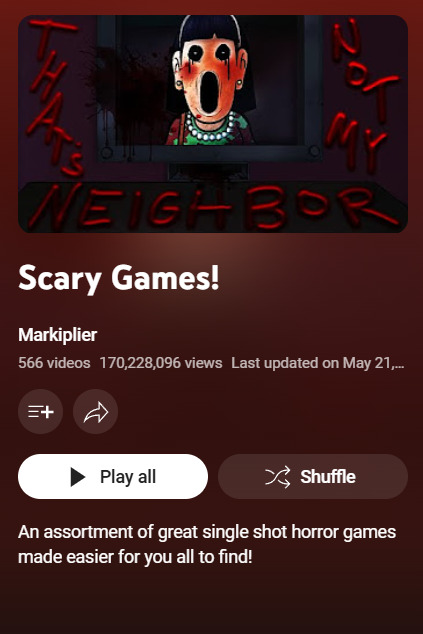

Baby's First Horror Game
The first horror game that I ever personally played, and actually beat instead of turning it off at the first sign of terror, was a game called Darkwood, officially released in 2017 by Acid Wizard Studio.
I didn't even play it off one of their recommendations either-- I had no idea this game existed in any capacity until one day in 2020 when I was scrolling through the Play Station Store, specifically looking for interesting horror games to try.
The first thing about the game that grabbed me was the horrific (in the best way) cover art, but what got me to actually buy the game and play it was its insistence on the minimal presence of jump scares--



At the time, and after the commercial success of Five Nights at Freddy's and its multiple sequels, a series whose staple was the jump scare; many horror game consumers became soured to that convention of the genre-- often calling them out as "cheap" and "out of nowhere lazy bullshit". This sentiment among the community was evidently common enough to be able to market one's game off of. I do remember thinking it was a bit pretentious-- giving off a major "I'm different from other horror games" feel-- but I guess it worked. because I did in fact purchase the game.
And they were absolutely in their right to claim their game as "an atmospheric horror experience that creates a feeling of tension without cheap horror tricks."
Dull of One Sense Sharpens Another
Despite the art on the cover, the actual game itself is pixelated-- for the most part. In fact, the only times when you aren't in immediate danger is when you're sat across from characters that look like this:



That is exactly what makes the sound and music design so genius though; it's that importance of it, that necessity. When the gameplay looks like this--

-- that is to say in a Top-Down perspective with generally dark and muddy, muffled colors; You have to listen for the threats, instead of just normally being able to see them in HD.
That's another thing too, as seen in the photo, there is a specific, defined area that is lit up where enemies can be seen. However, in the game, anything outside of that sliver of light-- anything behind you-- will not be visible until you turn around and shine your light on it. This leads to a lot of enemies inevitably sneaking up on you, and in this game's case where you have extremely limited health and stamina reserves (the red and silver bars in the top left corner), you have to learn to listen for them or else they will easily kill you.
I think then that the intense amount of focus I put into listening for sticks around me breaking, or for sounds of shuffling and growling, all on top of the general game's ambiance and soundtrack, conditioned my brain into focusing whenever the game's music plays.
The Buzzword
youtube
Darkwood, authored by Artur Kordas who had a large part in the development of the entire game, has a fantastic assortment of songs that all flow smoothly into each other-- and just they are designed to in the game, they fade into the background, providing a consistent atmosphere so that you can focus on the task at hand-- or at least so that I can.
There are also one or two songs that refuse to wash away into mood music. My favorite song on the album, "Underground", is a perfect example of this. It comes in with this slow and consistent, almost pulsating type of ragged noise, one that makes me picture an ugly, broken and dented, rusted, barely working trumpet, with an underneath layer that sounds like dragging stone against stone. Then around halfway through the song, an aggressive and exciting drum beat with hints of a metallic sound crescendos and crescendos, chasing the original set of sounds until it's all that's left-- completely overriding the grinding stone and leaving a thicker horn blare in replacement of the old one. This of course eventually fades into one of the common buzzing motifs found in many placing of the game's soundtrack, that's meant to signify safety, or hope.
This hasty, thrilling song provides a really nice break up and into the rest of the album, that is an even nicer subconscious reminder to my brain that there is danger if I do not promptly "pick up the pace" of my writing-- and further that there is safety on the "other side" of finishing my work.
Recommendations?
I have played many video games; some that have required a lot of my focus that aren't necessarily horror, but whose soundtracks really help me to concentrate; and I've played other horror games where the soundtracks end up more distracting than helpful. I've also played some games that are my favorites of all time, and I've put many, many hours into, where their soundtracks do absolutely nothing because they're just a little boring.
Darkwood is special in that way, where it lies in a neat, cohesive little combination that ends up perfectly suiting my need for background music when I write.
And I thought it was pretentious.
Does anyone else have specific videogame OST's that work like this for them? I'm always looking to discover new music, especially music that's ideal for studying and schoolwork-- and it definitely doesn't have to be horror; like I've said, I use multiple different genres of OST's to help me out.
Also, I feel like this goes without saying, but if you are looking for a horror game to play, I do recommend trying out Darkwood.
youtube
Or if you'd rather just listen to the soundtrack, I understand.
4 notes
·
View notes
Text
!!!! BSD5 EP10 SPOILERS !!!!

i take back all my ironypoisoned statements about bsd i loved that most recent episode a LOT a lot. its not like i disliked the current arc by any means, but it also reached a point in its absurdity where i stopped taking it too seriously - and MAN did this episode bring it back SO GOOD!!!
it did really well - between sigma and dazai being trapped in the flooded room, the sskk fight, the fyodor and sigma scenes, the bram and aya scenes - both with bringing all those subplots to very bleak devastating points, AND with something i have always always criticized about bsd: the violence here feels real, it has stakes - yes i expect a bsd-typical fakeout next episode after we saw dazai get (supposedly) shot to death, yes i know atsushi after being dismembered is probably gonna be fine, one way or another, cuzthats how this show rolls... BUT!!! BUT! let me bask in this until the next episode drops: the WEIGHT of it all!! how PAINFUL they made it!!!
bsd gives characters mortal injuries often, and doesnt really give them lasting impact. remember when atsushi lost his leg? kunikida lost his hands? or when dazai got shot in the eye in dark era? those bits essentially existed just for the striking imagery of violence - for the shot of dazai bleeding through his bandages, but he's still standing, pretty motionless, you know? and it's something you get used to with bsd, as much as i gripe about how the fights tend to not really have stakes...
...but this episode, though? i think going so long seeing these characters crumple and tear like paper and largely be fine, makes the absolute painful bleakness of this feel all the worse: dazai's crumpled on the floor from a broken leg, bleeding from the head, and he can't deliver many of his dazai-typical quips before he gets shot in the shoulder and just grabs it and screams. he doesn't get the satisfaction of being grabbed, or strangled, or whatever else by chuuya's hands, he doesn't even have the control of that: no, all he can do is just sit there while he's shot, over and over, and even when he's on a smarmy genre-savvy self-aware ramble, chuuya just stops him and shoots him in the head - and that's so fucking jarring and makes for INCREDIBLY striking imagery, i love it!!! for once, he's not safe! there's no plot armor! he's in so much pain and he is actively feeling it!!! AND THATS SO IMPORTANT TO HUMANIZING A CHARACTER LIKE DAZAI
AND THE SSKK FIGHT GOD DONT GET ME STARTED - the way atsushi's screams were voice acted, my god youd think they were actually tearing off yuto uemura's limbs in that recording studio. sweet jesus. you see people complain a lot about manga-aname adaptation changes but, as someone who hasnt read the manga, any cuts studio bones made were made up for by the absolutely brilliant audio - the music and voice acting - in every way, in this episode. the screams of pain. fyodor's gayass little stunt. so good!!!!!!!!!!!!!!
also sigma was awesome. aya was awesome. bram was awesome. fyodor made me feel a type of way (HIS ACTING WAS SO GOOD. MY GOD!!! TAKING ADVANTAGE OF SIGMA'S NAIVETE LIKE THAT!!! SPEAKING TO THEM IN TROPES BECAUSE THEY'RE LITERALLY A BOOK CHARACTER AAAUHHHH). 10/10 we are so fucking back. I LOVE ANIME.

#babbles#bsd spoilers#bungou stray dogs#AAUHHH I LOVE THIS ANIME WE'RE SO BACK WE'RE SO BACK#also theythemming sigma because i see the light now. i used to be like ':// eh kinda weird to only trans hc the feminine looking guy'#and like i still feel a biit weird if thats the ONLY kinda guy ur making Gender but like. i see them. i see them now
6 notes
·
View notes
Note
I would love to read your essays on the Barbie movie
Okay so to do a proper essay I'd need to watch the movie again a few times and it'd take me weeks if not months - in all likelihood I will not be able to convince anyone to publish it. That said my partner really wants me to write something so maybe I'll make the time. Until then: an extended kinda analytical review: WARNING: spoilers ahead:
Whenever looking at a movie like this its important to establish the genre and genre conventions before doing any analysis. The Barbie movie is a comedy, its satirical, and it’s a feelgood movie made by a corporation. Some of my gripes with this movie are personal taste, some are flaws inherent in these genres or production means, please take everything I say as personal opinion. (I say this because I have noticed people taking my opinions as law because of what I study before and please don’t’ they are just opinions.)
The Barbie movie could be analysed with a queer lens, and a feminist one. Queer theory is more my area, but the parts I’m going to be talking about often overlap with feminist theory. I’m not going to talk so much about the opening, but I will talk a bit about character. Following Stereotypical Barbie is a good choice for the film as it lets us analyse some parts of toxic femininity. This is more subtle than the films analysis of toxic masculinity, but it is present. The non-normative Barbie is ‘Weird Barbie’ according to the others, and nobody wants to talk to her. Our Barbie is ‘malfunctioning’ because she has thoughts that are wrong, her day isn’t perfect, her body isn’t perfect, and she doesn’t want to open her mind and do the work to change – she wants to stay the same. Non-conformance is undesirable. ‘Weird Barbie’ is unwanted and alone while the others have girls night every night and are beloved by Ken. The film doesn’t analyse this too far beyond a brief statement at the end that things shouldn’t go back to the way they are, and an apology to ‘weird Barbie’. I do think its interesting that the scene where Barbie is ‘malfunctioning’ is one of the only times her outfit isn’t pink. Instead she’s in blue. Blue is a colour that to my memory wasn’t used much in the film – and it did well serving to make our Barbie stand out in that scene. So obviously Stereotypical Barbie goes on her journey and discovers things about herself and others – learns the world isn’t perfect. I don’t know how I feel about the conclusion of her becoming human at the end. I understand the thought process here – Stereotypical Barbie can’t exist as she is, her perfection is unattainable. She needs to become human because Barbie does need to reflect humans more, its why there have been so many variations over the years. That said it felt cheesy, the montage about understanding what being human means felt hollow and empty – I remember a lot of women and girls laughing and playing, I do not remember grief, failure in amongst the success. If the warning is “understand what it means to be human” I would have expected the good and the bad together. I know there are differing opinions on the concluding scene, but I personally think it was a misstep. Having Barbie becomes real = Barbie gets a vagina, felt like it went counter to the previous message of “Human isn’t something I have to ask for, its just something I realise I am one day.” Barbie already became real because of her thoughts and feelings, making her have a vagina at the end felt weirdly essentialist.
Now, onto the Kens.
The Kens are a great example of what one author (Jack Halberstam if you want to find them) I’ve been reading calls ‘Kinging’. They draw the term from Drag Kings, as a parody of masculinity – a bit earnest at times, but often exaggerating and playing off masculinity for comedic effect. The examples they give in their book include Austin Powers – but honestly this movie feels like the best example. The Kens are childlike, they’re a bit stupid and at least at times well meaning. Our Ken learns about the patriarchy but doesn’t understand what it means and brings it back to Barbie Land anyway. The inversion of reality to Barbieland is an interesting one – the Ken are too reactive and too stupid for politics – something the film barely comments on or analyses beyond a tongue in cheek joke about the kens one day having as much power as women do in the real world. I don’t think this is a bad thing, inversion for the sake of a statement is fine – and if men watching don’t understand that ‘of course men aren’t actually like ken’ is the point that’s on them. Also ‘I’m just Ken’ has been in my head for a solid day now. There could be a discussion about how “Sugar Daddy Ken” and “Magic Earring Ken” were not subscribing to the instated patriarchy Our Ken brings back from the real world. I’m not sure if this was a good choice or not, very ‘Ladies and gays’ moment. That said the ‘Weird’ Barbies and Kens do have to break the normal Barbies out of their brainwashing so I suppose its more of a commentary on counter cultures recognising the flaws of society? Now onto where I really think the movie fell flat. The CEO and board of Mattel. For the Kens, being stupid, bumbling and a bit over the top made sense – they’re dolls. For the board of Mattel it came off much more as ‘if we make this funny its less threatening’ when actually no it should be threatening? In reality the board has one less woman then men, though the company is still predominantly male. This whole running gag just sat badly with me. It really felt like “no no no the corporation is harmless, honest.” At the end of the day nothing changes in the real world – and again I get that’s part of the point, the real world takes more work than one imagination and one movie. But our lead, real women don’t even seem to be that empowered by their experiences? Its implied that one remains at her day job and the other, although having a better relationship with her mother, doesn’t see the real world any differently. Theres a little bit of an element of ‘whats the point’ that feels counter to the films message. I’m probably being just cynical here – again change is slow, change takes communal effort. Finally, although touched on the film could have done much more to look at its own consumerist message. Its kind of a throw away line – and that Barbie is unattainably perfect is ‘solved’ by one request for an ordinary Barbie which Mattel agrees to because ‘it will sell’. The film barely grapples with this which is a shame because given how much of the rest of the film had really interesting dialogue on society, gender and personal identity, I think they could have done some interesting things with consumerism and capitalism. Anyway this is just from one watch through and a bit of time to think, I’d need a lot more time to solidify some of these ideas and work out a full analysis (ideally with more costume elements involved).
7 notes
·
View notes
Note
Tell me about your stories! What kind of stories you like to write? Any particular themes you like to explore? Any trope you're fond of (plot or character wise or both)? What inspire you as a writer?
Thanks so much for the ask!
I’ve been writing for as long as I remember; I think I must have written my first short stories when I was still at primary school and then got a bit more serious about it in high school (I held the school record for most words ever written in an essay for a very long time—brevity is not my forte, in absolutely nothing I write).
I am bilingual, and I usually write in my other language because I perceive it as slightly stronger (I grew up in a different country, my mum didn’t speak English with me, only my father did. I moved to an English-speaking country some 20 years ago though and mostly speak English today). My published books are all in my other language. However, I write fan fiction exclusively in English, for a million reasons, but mostly because it gives me a different voice I guess, and I can stay anonymous 😂? In any case, it’s quite interesting to explore how your voice changes between languages…
I love writing dialogue. It’s my greatest strength and my biggest weakness. I had editors tell me to look into screenwriting, and I always need to watch that I don’t write talking heads. I am not particularly fond of reading pages of descriptive text to set a scene (I don’t care about every tiniest detail of a wallpaper, unless it is truly essential for the plot and your name is Charlotte Perkins Gilman), so I think that has always bled into my own writing. I personally detest purple prose, it makes my eyes glaze over, and I don’t think it’s necessarily good writing to be ornate for ornamentation’s sake. It always reads self-indulgent to me and disrupts the narrative flow.
What inspires me? The human condition, psychology and philosophy, and although I mainly write (often steamy) romance, all my works deal with existential questions. I sometimes think it’s only romance because there’s a love story at its core, and I’ve definitely written stories that my publishers handed back to me because they didn’t fulfil genre expectations for romance enough (romance is probably the genre with the least breathing space, and publishing is a whole ‘nother topic).
Generally speaking, I think I just like people, despite being the worst introvert in existence (I am not shy, neither do I have social anxiety, and I find it important that people get that cognitive introversion is not the same as being anxious or shy. I can convincingly pretend I am an extrovert and have done presentations and performances in front of hundreds of people without problems. I can also start conversations and keep them going without trouble, and my whole life is built around human connection. But I can only do so much of it before I need to lie down in a dark room and feel completely drained, and I mostly live in my head if given the choice).
I like to write about human relationships, about grief and loss, also about trauma, but not in a self-serving way. I think the fact that I am a therapist (amongst other things—complicated life story) always makes me look at a way through instead of lingering on it, while at the same time acknowledging that these things stay with us forever. There is no life without them, but there is living with them.
I like to write female characters, and near all my works have female protagonists. I write both f/m and f/f relationships. I detest the caricature of strong women characters that seems quite popular though—they do everything the way a man does, have the physical strength of a man and generally behave like a bitch. I believe strong characters are not afraid of their vulnerability, and I find that a million times more interesting to explore and write.
Apart from that, I can work with most tropes and wouldn’t have particular problems with any if they slot nicely into the plot, but there are definitely some I haven’t written because there was just no opportunity yet, or I don’t find them particularly interesting. I mean, most of us are walking tropes in one way or another, but we’re also more than that. Am I particularly fond of particular ones? I don’t know. I quite like the idea of soul mates, and although it’s not always realistic, it’s interesting to write because it makes us think about what is important in ourselves and our connection to others. So I rather see it as an exploration of human connection than something that is the be all, end all. Funnily enough, I often write friendships that go into that direction, so it doesn’t always need to apply to sexual/romantic relationships. Even my fanfic has a female friendship in it that somewhat falls into that category, and it was important to me not to sideline it, despite it not being the main plot.
#asks open#send asks#about anything really: sandman | writing | life#about writing#my writing#on writing#writer#writers#writing#writers on tumblr#original characters#asks answered#asks
4 notes
·
View notes
Text
Movie Review | Jennifer's Body (Kusama, 2009)
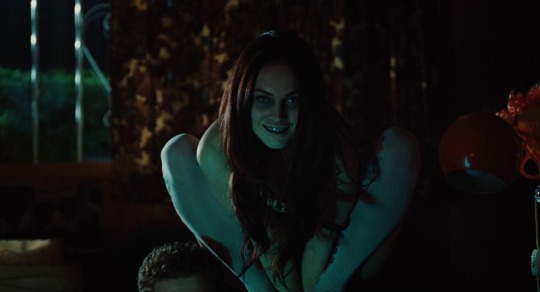
I remember seeing this aggressively marketed during my last year of high school with a campaign that wanted to capitalize on Megan Fox’s popularity yet failed to distinguish this from any other horror movie being made at the time. To be perfectly honest, perhaps because Fox seemed to be pushed on us in a concerted effort with her Transformers movies, like the powers that be were dictating that this is the person we have to find hot now, I was maybe a bit put off by her at the time and ended up staying away. Now that she’s making DTV genre movies and no longer seems to be the “It” girl, I’ve been able to overcome my anti-Fox prejudice and finally decided to check it out. I think I made the right call to wait, because I ended up enjoying it a good amount, which I suspect wouldn’t have been the case in 2009.
For one thing, this banks heavily on the viewer finding Fox attractive, so if you were put off by her at the time, it probably wouldn’t have entirely worked. If anything, with distance, one can appreciate that her casting is very much part of the movie’s satirical aims, as she represents the idea of a hot girl as much as she happens to be one. And to the movie’s credit, it does the legwork to sell you on her attractiveness. The gaze of this movie is arguably bisexual, training us to view Fox not just from the viewpoint of all the horny guys in town, but also her female best friend played by Amanda Seyfried. Fox seems to positively glow, even when she’s experiencing some version of vampiric withdrawal symptoms (that really just make her look gothy). And lest I chalk her role up just to stunt casting, I found Fox quite effective in the role. She’s effortlessly sexy, jaded and cruel, but also brings a nice physicality during the horror scenes. It’s interesting to think that she might have become a horror icon had this come earlier in her career, but that would likely undermine the movie’s satirical potency.
Now, you’re probably thinking that the characters played by Seyfried and Fox would not likely be friends in most cases, and the movie astutely fleshes out the imbalance in their friendship, that one is less important to the other but that some degree of codependency still exists. The dialogue by Diablo Cody on one hand is arguably a bit too written and too ready to wheel out uncharitable terms for other groups, but I think there’s an emotional truth to the dialogue. Teenagers say offensive things all the time, and think wittier than they are. This is the kind of dialogue they wish they could come up with.
Now I did just say that time has been kind to the movie (and its growing reputation seems to prove that), but a lot of its satirical power comes from its specific context. The movie is submerged in a Bush era atmosphere of performative, insincere mourning, with seemingly everybody in the town somehow in tears despite only loose connections to the instigating tragedy, characters being labeled as heroes despite a lack of heroic actions, 9/11 commemorative shots and benefit singles where a whopping 3% of royalties go to the impacted parties. If anything, this suffers a little from Paul Verhoeven syndrome, where the movie seems indistinguishable from the things it’s parodying, in this case, the kind of slick 2000s made for the multiplex horror movies that got no respect. (One of the movie’s few defenders at the time was Roger Ebert, who despite his notable aversion to horror, was always full of surprises.)
One last note: Chris Pratt appears in this for like a minute, and his casting plays like a joke on his future career. Another way in which time has been kind to this movie.
2 notes
·
View notes
Text
lecturers - 16/072024
Discussion on the group changes and the presentation for stage one.
Questions....
Reflecting on the context where we consume and make films/art...
2. What film styles/genre are you drawn to? why?
As a kid, I remember watching a lot of animated movies with my cousins and watching major action-packed Hollywood films with my parents. I also remember watching some old Sinhala black-and-white films, Sinhala dubbed Japanese/Korean and Indian teledramas with my grandmother.
During my teenage years, I got into anime movies/series and K-dramas thanks to some of my school friends.
Overall, I feel like I've watched various types of films since childhood, and going down memory lane has helped me figure out my ideal and genre of film.
My favorite film style -
Neo Noir - Even before I knew such a film style existed, I found myself interested in movies like Seven, Zodiac, Shutter Island, and Blade Runner.
I'm such a big fan of the dark aesthetics of these films and the well-thought-out plot twists. More than the morally grey protagonist, I would say that I'm always invested in figuring out who the mastermind antagonist is, and I find myself trying to figure out their purpose and next big move. (What I mean by this is that I'm invested in their thought process of cooking up this messed up plan and what pushed them to this point of breakdown)
My favorite film genre - Action, Crime, Thriller
Thriller - As a neo-noir fan, I'm pretty much a thriller fan. Horror can be a bit too extreme with the jump scares and the supernatural stuff, but I think thriller has a well-balanced horror to its genre. In a way, I feel like thriller movies give an important message of judging and understanding the people you are with. Don't judge a book by its cover.
2. Crime - I may have not read a lot of Sherlock Holmes books, but I've definitely watched many detective/ crime and mystery movies. would even say that my favorite movie character role would be the 'detective'. Detectives are bold and just and they will do anything to solve all these mysterious cases before them and I'm here to enjoy the show!
3. Action - My love for action would be thanks to the old Marvel movies <3 (The new ones are bad...) It may sound silly, but I remember watching the 'Avengers' movie when I was 12 and I felt this heroic inspiration in me. And the action-packed fight scenes kept me on the edge of my seat. So, any good action-packed movie with some comedy sprinkled in it is what I'm gamed to watch.
4. Romance - I don't usually find myself watching a lot of romance films since most of them can be cheesy, too corny, and give me secondhand embarrassment, but movies like 'Pride and Prejudice', 'Eat Pray Love', 'Kate and Leopold', and 'Under the Tuscan Sun' are classics that make me believe that love might just be a magical experience. (Or it may just be 'magical' only in the movies TOT)
3. what sort of films/art has influenced your current practices?
As I've mentioned in my answer to the previous question, I would say that neo-noir films have influenced my way of thinking imaginatively and also for story writing.
In terms of art, I would say that my art style has been influenced by anime. At the same time, however, looking at the classic artists I would say that Van Gogh's artwork in terms of color palette usage is to my liking.
4. what sort of work you like to explore and draw inspiration going forward?
I would say that I would like to explore more Sri Lankan stories as a future animator or filmmaker.
I believe that our country has been blessed with some amazing historical stories. Unfortunately, most of them haven't been taught in an eye-catching manner.
I remember during O/Ls, I had to suffer through, reading chunks of paragraphs with unnecessary information only to find a few important sentences for the exam. But looking back, it's not that those stories weren't interesting. They were just not taught properly.
So, in the future, I would like to revisit all these history-related stories I had to memorize and animate them in a way that they will be interesting for students and even foreigners to watch.
Discussion on Martin Wickremasinghe and Lester James Peiris!
existentialism/ absurd theater
MADOL DOOVA (island filled with mangroves) - published in 1947, author Martin Wickremasinghe
List down important contributions by Martin Wickremasinghe to Sri Lankan literature :-
List down important contributions by Lester James Pieris to Sri Lankan cinema :-
Reading Madol Doova :-
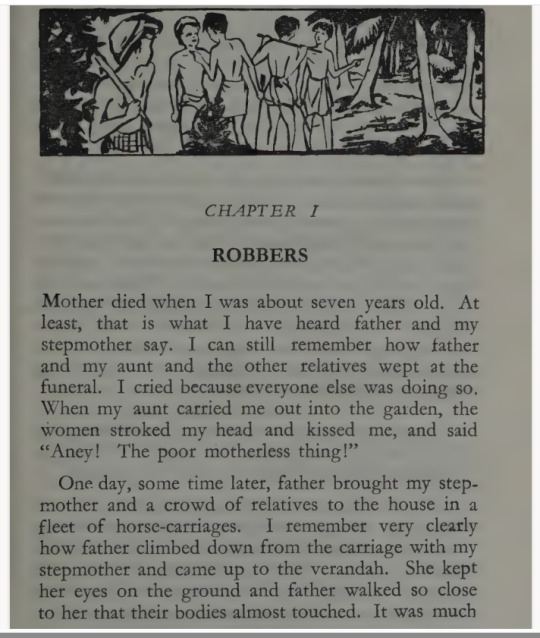
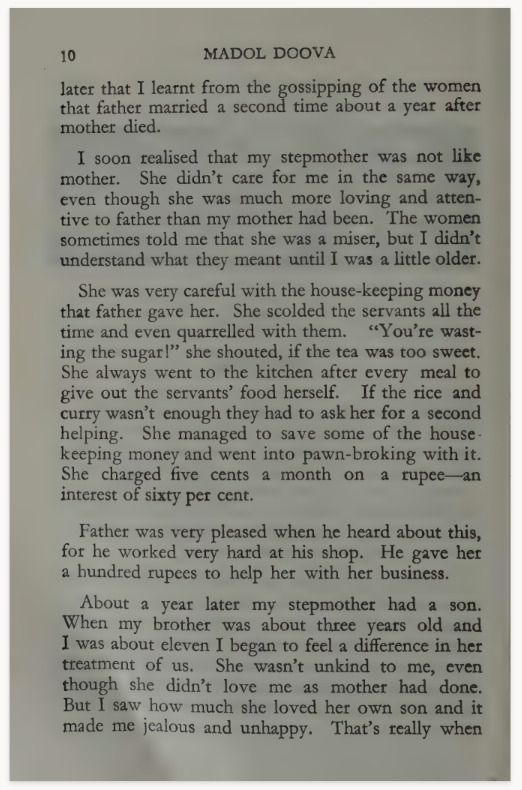
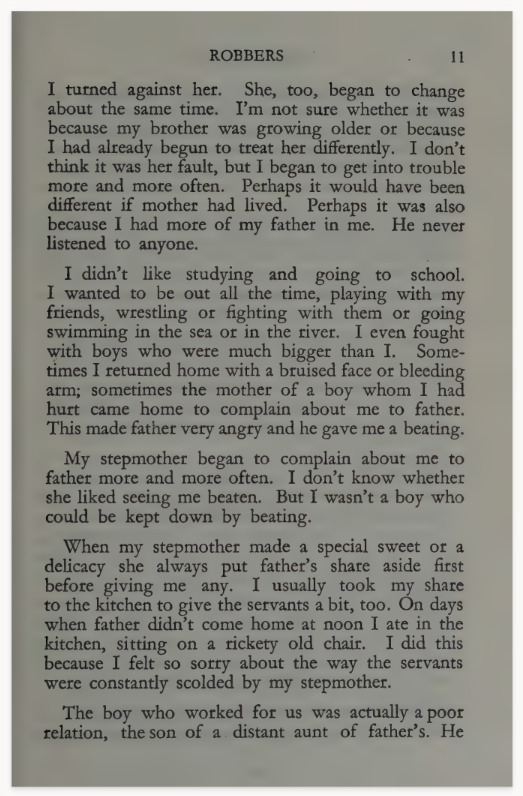
ambalama - A place where travelers can rest

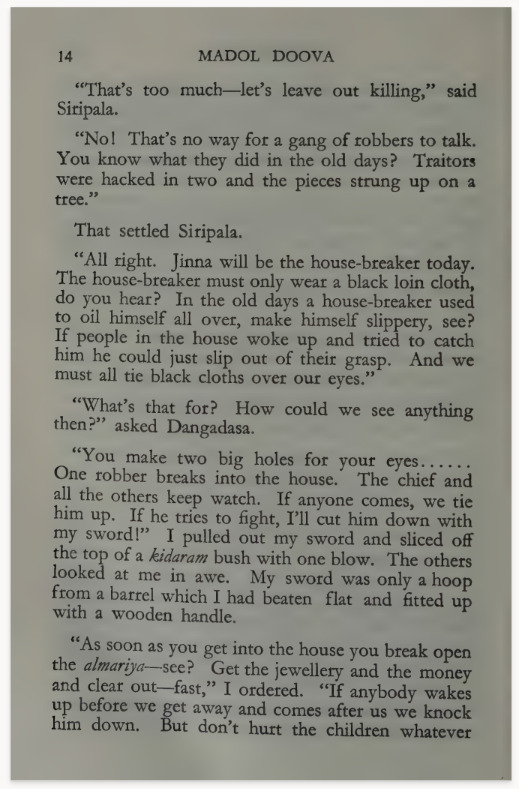
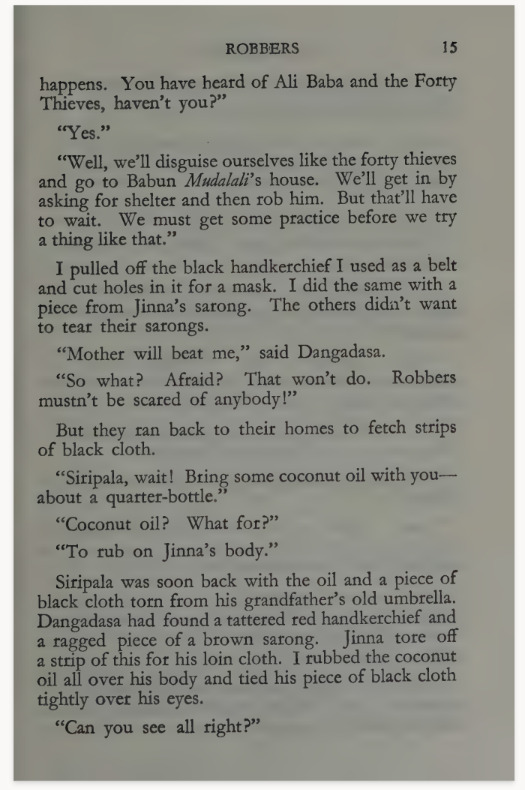
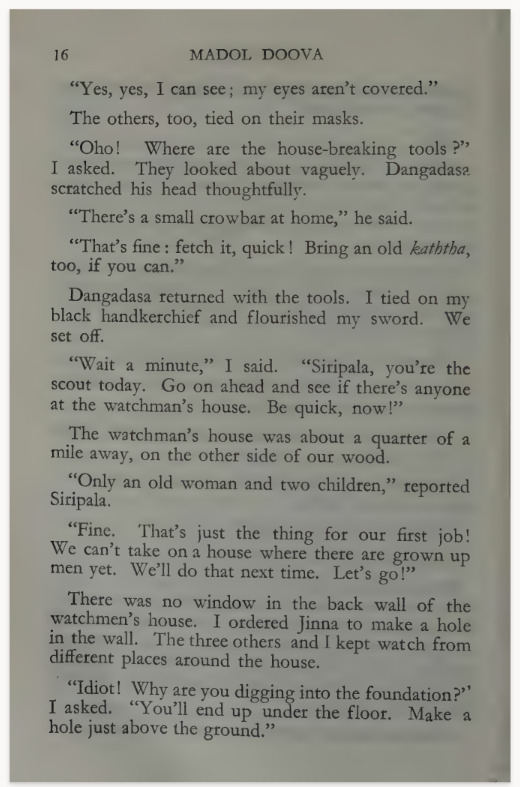
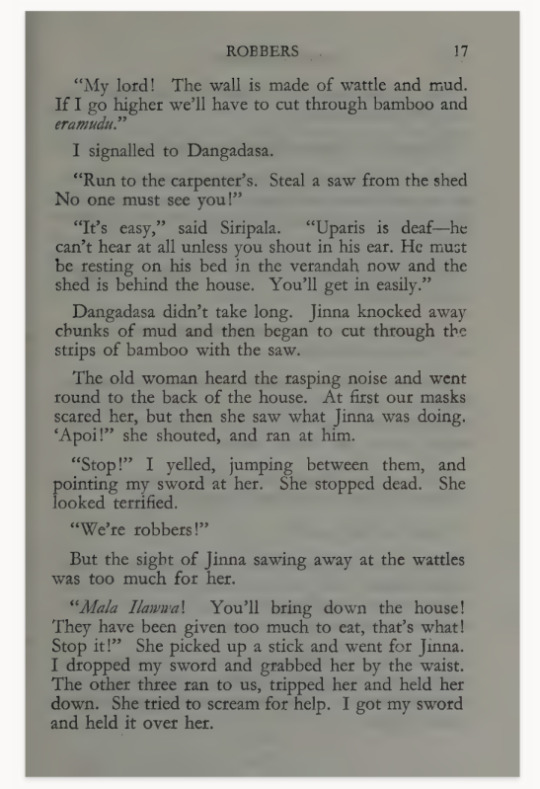
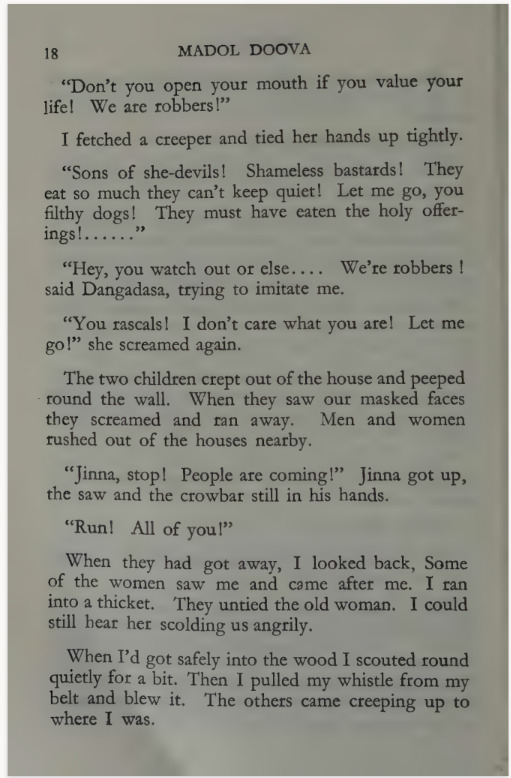
watching the film!
0 notes
Text
how to make your writing be remembered forever and possibly be well loved.
(incredibly stupid and silly fanfiction line at the end of this post) I know that title is incredibly daunting but listen, its very simple. you ready?
MAKE STRONG CHARACTERS
"but kat! surely its not that simple! " nononono listen. bear with me. I want you to think of your favorite thing. Now ask: what do you remember the most about the thing you love? I will go first:

I love team fortress 2. and guess what: this game has been around since 2007, and was in development hell since before I was even born. The game has been around for 16 fucking years. And guess what? in the strong year of 2023 team fortress 2 Is STILL getting memed about. and do you want to know the crazy part? the character designs to the naked eye are not special at all. ok sure from a designer standpoint, these are very well designed characters made so that you can easily tell who they are based on their silhouette. but from the average joe.... tf2 is iconic but overall it looks ok. it doesn't seem special to a stranger to tf2. look at this completely random and arbitrary example of a game in the same genre:

I don't know shit about the characters in overwatch. Yeah i have a BASIC idea on what their personality is like based on voice lines and some videos i guess... but in-game they just exist. these characters are brightly colored, they have beautiful unique designs, hell they have even more diversity such as robots and people from other cultures! but i don't remember shit about these characters. Maybe I remember the ice lady and tracer, but nothing else. and yeah part of overwatch struggling right now is incompetant development, BUT: The characters in team fortress 2 are SO remember-able because the characters have such a vibrant personality. I am an orange box owner, its been a decade and a half and I am still remembering this game and enjoying art about it.
"but kat! that is a comedy game! Overwatch is a very serious game! are you saying comedy is needed to make a character more noticeable?" no. though I think allowing your characters to lighten up every now and then would humanize them. Not full on goofy, just give them something that makes them likeable. and if you cant do that, you can STILL make a compelling character even though they are mostly seriousness. I have an even more awfully thought out example:
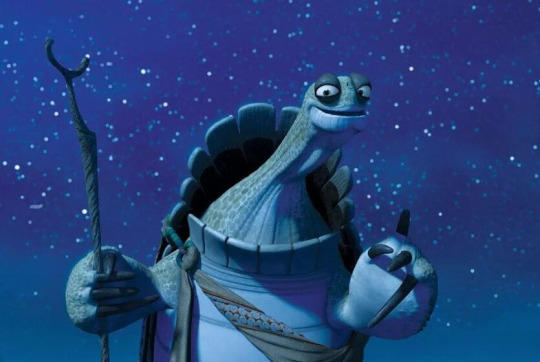
kung fu panda is a masterclass in making a serious comedic movie somehow work. Master Oogway.... he isn't a comedic character at all. Yeah we made memes about him, but ignoring that, he is a wise and resourceful person. He is at calm and has faith in this intuition. there are a lot of characters like this. What makes Oogway stand out is that he is also a little bit kooky and sassy.
youtube
this youtube clip sums up what I mean. It is a funny line, it fits the character, and It doesn't ruin the seriousness of the moment. Some of the most successful series in history have something about them that has appealed to people. In my opinion: characters with strong personality and interesting traits is always a good way to ensure your writing is successful. The second most important is the characters bouncing off of each other in terms of their chemistry with each other. There is a reason why I spent years playing the first Destiny game and all of the DLC, but I remember fuck all about the characters. I think I maybe remember the bootleg star lord robot guy.
A writing exercise
here is an exercise to get you in the spirit of character making. step 1- get a random character from a random bit of media. In this case let me bring you master Oogway. Step 2- Get a completely different character from a completely unrelated series. I am going to give you Scout from team fortress 2. step 3- write a random ass thing about them interacting. Think about how the characters would react to each other and why. Think about each characters values in life and think about how they would bond and conflict with each other. Think about characters similar to the character they met in the past and how they reacted then, and if they have never interacted, make something interesting with it. Step 4- keep experimenting. Once you get into the spirit you can apply this to any new character you could want to make anyways thats it byeee- "arent you going to do that ?" do what? "make a writing thing about oogway and scout. " ........
Scout: let's go turtle you got nothing on my speed- Oogway: The one who first resorts to violence shows that he has no more arguments. Scout: that sounds like chicken talk! come on tough guy let me have it- Oogway then proceeds to make scout eat shit before vanishing in a cloud of cherry blossoms and dust from the desert. If this post isn't popular I want you to know my dignity was lost for nothing.
#please read the post before you comment “oooh no why do you have so many random tags”. they are not random this post is just weird as fuck#trust me on this this absolutely does actually have something to do with both kung fu panda and team fortress 2 please read the post first#also fan art or writing bits based on the oogway and scout interaction I made would be 100% appreciated and loved by me.#I would love to see what yall make based on the exercise i made!#writing tips#writing advice#creative writing#writing#writers#character analysis#team fortress#team fortress 2#tf2#overwatch#overwatch 2#kung fu panda#master oogway#tf2 scout
691 notes
·
View notes
Text
MY SCHOOL PRESIDENT – REPRESENTATION MATTERS
Maybe it's just my own wishful thinking, and maybe it's too early to tell for sure (though I don't think so), but remembering what Producer Aof, Director Au and the rest of the team did with Bad Buddy – it looks like the MSP team is giving a positive shout-out to the spectrum, even while anchoring the series firmly within the BL genre.
We have–
TinnGun – gay
SoundWin – gay, though Win may be bi/pan
TiwPor – likely gay
YoNook – straight
And Ep.7 suggests Pat may be straight/bi/pan but he comes across as more ace or arrow (to me at least).
And FINALLY the lesbians get a mention! 😍
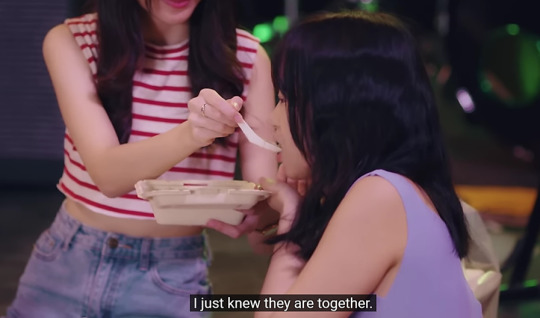
(above) Ep.7 [3I4] 5.04 – musical-loving lesbians exist, even if they do break Pat's heart
I'm just hoping they give us a trans character somewhere too – oh WAIT a goshdang hot Bangkok minute, they already did! 😍
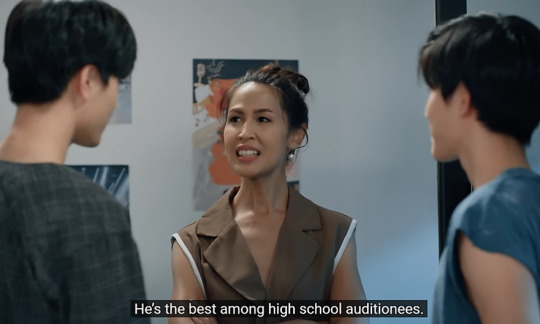
(above) Ep.5 [3I4] 7.13
The role of the producer at GMM Music in Ep.5 was played by actor and host Golf Kittipat Chalaragse, who openly identifies as a transgender woman.
It's important to note that she is treated by the boys with utmost respect in her one scene, and also that she broke disappointing news to Gun (not being shortlisted for signing despite his obvious talent) with kindness and empathy.
This quietly positive portrayal of a trans character in a position of influence is important for all the trans kids out there who might be watching this. (And yes, I'm aware that Golf's character in the show is not specifically identified as trans, but given her fame in Thailand I think most Thai viewers would see her as such.)
Bearing in mind that My School President is a lightly-crafted Thai-style High School Musical taking place in a QL universe, I believe that it is still carrying the sense of mission previous (more strident) Thai QL dramas have been sounding – The Eclipse, Not Me, and even Bad Buddy come to mind.
As with most other QL series, no one is treated as being less than anybody else based on gender or sexuality. So the boys take their Ep.6 music video – about the awkwardness of being in love while in the friendzone – happily into BL territory, free from any fear of societal judgement.
Previous dramas that did this (to the best of my memory) had an older target demographic, but this one is sending out a message of hope and normalization to a younger audience that it's OK if your sexuality or gender isn't society's perceived norm.
And to those who fit within the perceived norm as well, there is also the messaging that the trials and tribulations of your queer friends, family and compatriots have a lot in common with the dramas of your cishet lives too – so maybe it's time to stop othering anybody for being a little bit (or even a lot) different. (This is ultimately the message behind the switch from straight couples to BL ones in the Ep.6 music video, and also the BL switch in Bad Buddy's Kwan-Riam musical.)
It's not the first time a BL has been sending out messages geared to bolster queer self-esteem and normalization, but it's the first high school one in recent memory that seems to be radiating positivity all around, and hopefully its message will land with the younger set.
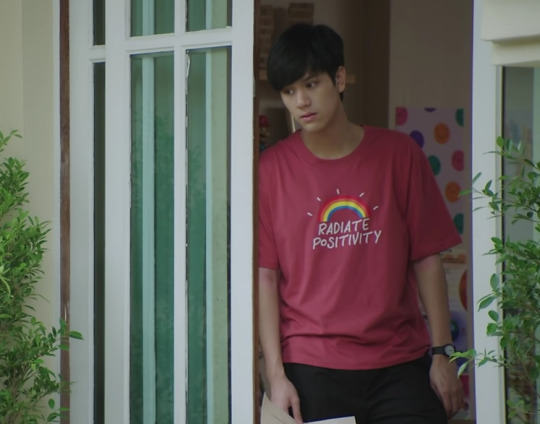
(above) Bad Buddy Ep.10 [2/4] 12.20 – Pran's t-shirt wasn't ahead of its time, but its message still applies a year later
Heartstopper may already have done this, and its finished product is perhaps a bit more realistically grounded and polished, but that show was restricted to a smaller, paying and arguably older audience on Netflix.
I cannot begin to emphasize how important it is that My School President and its messages of positive self-worth are beamed free-of-charge to LGBTQ+ teens all over the world, including places where it might not even be safe to be openly LGBTQ+.
My School President may be going all out to entertain (and it does), but beneath the froth and fluff it's still doing something. With the team behind it I wouldn't have expected anything less. And I'm so glad they're at it still. 💖 👍
#my school president#sexualities on the spectrum#LGTBQ+ representation#positive self-worth around the world
76 notes
·
View notes